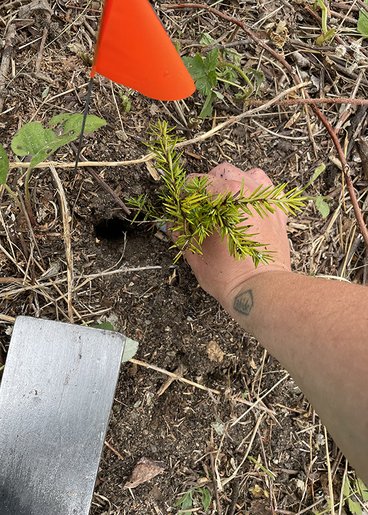
Boosting eastern hemlock: Research to restore Minnesota's endangered tree species
Graduate student Kira Pollack is leading research to find out what increases survival and growth in eastern hemlock seedlings to help boost the species out of the endangered category.

The eastern hemlock is Minnesota’s rarest tree species. The slow-growing, long-lived conifer used to be common across the state’s landscape, but overharvesting, wildfires and severe weather events have contributed to the species decline across the state. With a mere 50 wild trees remaining across the state, eastern hemlock is classified as endangered in Minnesota.
Kira Pollack, a graduate student pursuing a Master’s of Science in Natural Resource Science and Management, is working with Andy David and Marcella Windmuller-Campione, both Associate Professors in the Department of Forest Resources, to give these trees a much-needed boost.
Eastern hemlock provides numerous ecosystem benefits - it regulates nearby soil and water temperatures, and its dense canopy provides thermal cover for deer and other wildlife. Landowners and forest managers are interested in restoring eastern hemlock in Minnesota for these ecosystem benefits as well as for aesthetic purposes, but there is little existing information on how to best go about reestablishing the trees.
Tracking eastern hemlock across the state
To provide more information about how to best plant eastern hemlock, the research team wanted to know where people have already tried planting it.
“We knew of the ‘officially recognized’ trees in Mille Lacs, Kanabec, Pine, Carlton, St. Louis, Itasca, and Aitken counties because of the DNR’s work” says Pollack. “But just by looking at iNaturalist we also knew that there were trees beyond that, including about 10 right on the University’s St. Paul campus.”
Pollack developed a survey asking forestry professionals and landowners for locations, site conditions, height, presence of cones and regeneration, and known histories of eastern hemlock trees. The goals were to find out where people had planted the species successfully and identify what factors might be impacting growth.
“With our survey, we found successful plantings throughout the state, from Lake County west to Beltrami County, and southeast to Winona County, with most participants describing their hemlock as doing well,” Pollack shares. The survey results also found that a reported 93% of trees 20 feet or higher bear cones, which indicates that the planted trees are adaptable to Minnesota’s soils and climates.
Investigating early success
Pollack says that with the valuable information from the survey, the research question shifted from ‘can eastern hemlock grow elsewhere in Minnesota’ to 'what factors influence eastern hemlock’s growth in Minnesota’.
With that in mind, the research team established trials to better understand what influences the species' success in its early years. In early summer of 2023, researchers planted over 900 eastern hemlock seedlings at trial sites in four different locations across northern Minnesota.

The research team is studying if certain seed sources are better adapted to Minnesota’s changing climate. They’re also testing whether placing untreated wood blocks next to the seedlings increases their survival rates by giving shade and helping the seedlings retain moisture as nurse logs would in the wild. The trial sites will be monitored consistently for the next two years, and periodically long-term to see how well the seedlings grow and how they fare after Minnesota’s grueling winters.
“Eastern hemlocks are charismatic trees. Professional land managers and laypeople have already shown interest in the results of the planting trials even though the data is years out. It’s clear we have the investment to bring hemlock back to Minnesota, now we just need the knowledge.”
Pollack will work with David and Windmuller-Campione to identify site selection best practices and planting methods that maximize the survival and growth of eastern hemlock seedlings throughout the state. Crucially, they plan to share those findings with natural resource managers and landowners who can, in turn, use the information to give eastern hemlock seedlings the best shot at success when planting.
“Eastern hemlock isn’t the best at self-propagation,” Pollack says, “but it is persistent. If we can find better ways to help it grow where it’s planted, then we can use that information in future restoration work and boost the population out of the endangered category.”
Funding for this research is provided by the Minnesota Environment and Natural Resources Trust Fund as recommended by the Legislative-Citizen Commission on Minnesota Resources (LCCMR).





